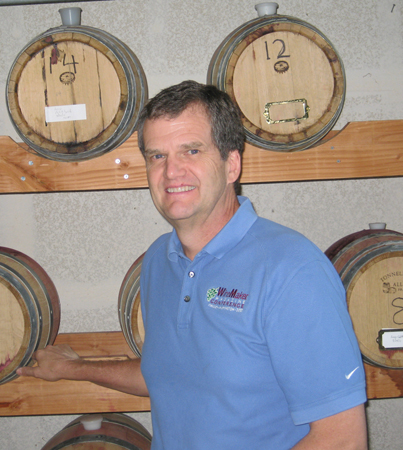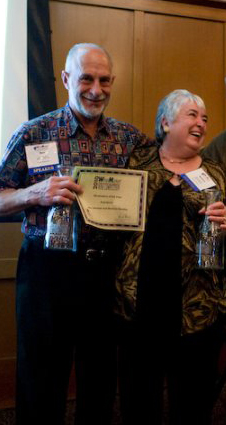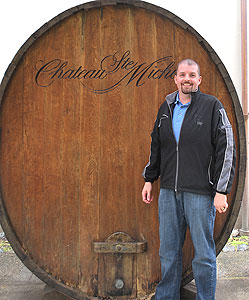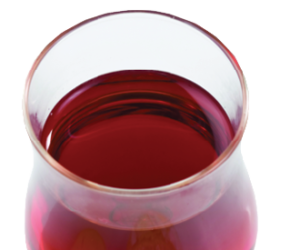What does it take to make world-class wine at home? Over the years since WineMaker started hosting the WineMaker International Amateur Wine Competition, many readers have written in asking variations on that same question. Is it the fruit? Is it the winemaker? Is there some sort of magic yeast strain or enzyme that might make a so-so wine into something gold-medal worthy? There are no magic tricks to making better wine, but there are certainly some ways that you can improve your wines. So how do you make wines that win medals? You ask the experts, of course! We persuaded three of the WineMaker competition’s frequent medal winners to share some of their award-winning secrets for making red wines.
Winemakers
 Dan Boykin, Concord, California
Dan Boykin, Concord, California
Awards: Gold in Cabernet Sauvignon, Gold in Zinfandel, Gold in Malbec,
2 Bronze in Bordeaux Style Blends, Gold in Shiraz/Syrah, Bronze in Zinfandel, Gold and Silver in Other Red Vinifera, Bronze in Red Vinifera Bordeaux Style. 2 Gold and a Bronze in Port Style
 Rex Johnston, Walnut Creek, California
Rex Johnston, Walnut Creek, California
Awards: Winemaker of the Year, multiple Best of Show winners over the years
 Jason Phelps, Londonderry, New Hampshire
Jason Phelps, Londonderry, New Hampshire
Awards: Gold and Bronze in Bordeaux Style Blends,
Bronze in Cabernet Sauvignon, Bronze in Port Style
What kinds of red wines do you make and how?
Dan Boykin
I make the classic five Bordeaux varietals: Cabernet Sauvignon, Cabernet Franc, Merlot, Malbec and Petit Verdot from fresh grapes or frozen must.
I stick to the book as far as yeast rehydration, feeding, etc. Treat the yeast well they will make great wine.
Rex Johnston
I make six reds (when I make reds), but I don’t make the same reds every year. I make Cabernet Sauvignon, Cabernet Franc, Merlot, Petit Verdot, Malbec and Red Meritage. I also make six whites: Sauvignon Blanc, Sémillon, Gewürztraminer, Viognier, Chardonnay and White Meritage, as well as ten to twenty fruit and dessert wines which vary from year to year.
Jason Phelps
I make Merlot, Amarone, Cabernet, Pinot Noir, Rhône Blends, Malbec and Syrah. I make them from kits, fresh grapes and fresh juice, depending on the varietal and availability.
I make small batches of about 1–6 gallons (3.8–23 L) each, as well as many small 1–3 gallon (3.8–11 L) experiments — all with simple winemaking equipment in my kitchen.
How many wines do you normally make in a year?
Dan Boykin
I make a large batch of each of the five varietals I listed earlier, plus Syrah, Petite Sirah and Zinfandel. I also make a Port (or two or three) from some of the above. Last year I made the rosés from saignée into Ports. In fact, the Petite Sirah Rosé Port is one of my best wines ever — and it was an experiment!
Rex Johnston
Fifteen to twenty five.
Jason Phelps
Overall I make roughly ten to twelve styles that can range in volume from ultra-small batches to 6–12-gallon (23–45-L) size batches.
For reds, I make three to six batches, and I expect to make about that many again this year.
For fresh fruit winemakers, where do you source your fruit, and why?
Dan Boykin
I make all from grapes (frozen must or fresh, just depends on the circumstances or time of the year).
I did make one Port from frozen blueberries, frozen made it easy to extract all the flavor and other good stuff without actually crushing them.
Rex Johnston
I get plums and apples from my backyard, berries and plums, etc., from the farmer’s market, and things like rhubarb, mangos and strawberries from the grocery store.
Jason Phelps
I buy most of my fresh winegrapes from M&M Wine Grape Co. (out of Hartford, Connecticut). I also get juice, must, and frozen crushed grapes from them, but also from other sources as well. I should note that I have only two years of experience making wine with grapes.
For kit winemakers, explain how you choose the best wine kits?
Rex Johnston
I simply choose higher-end kits, often aromatic whites.
Jason Phelps
I most often buy kits based on recommendations from people who have made them. I like to choose niche styles that are hard to get in fresh fruit form.
Choosing wine kits based on past medal winners is a good guide.
How many wines did you enter in this year’s competition? How frequently do you enter your wines in competitions?
Dan Boykin
I entered 12 wines in the 2011 competition and was surprised with one of the wines I just entered only because I had an extra space in the shipper — it got a gold! I enter four competitions every year, and I try to get every wine into all four, that way I get feedback and pick up the various nuances of each set of judges. I have found remarkable consistency in individual competitions, but amazing variety between each. One got double gold in one and Bronze in another. But when I get gold or silver from several I know I hit a good wine.
Rex Johnston
I entered 15 entries in this year’s competition, and I typically enter around 4 to 7 competitions each year.
Jason Phelps
I entered ten wines in this year’s competition, and I tend to enter only one or two competitions per year. I love the feedback that comes from the judging notes, because it helps me to train my own perceptions.
How do you select and prepare the wines that you enter in competition — for example, do you randomly select bottles from a batch?
Dan Boykin
I just grab one from the case. I have started keeping permanent labels off a few (just stick an easily removed temporary label on it) when bottling, which makes it easier at entry time.
Rex Johnston
I check each for sediment, clarity and leakage before packaging them for shipping.
Jason Phelps
I taste, taste, taste. I look for wines with high clarity, good balance and solid aromas (in addition to great taste).
Typicity (the degree to which the wine reflects its varietal origins) is also a consideration, sometimes it is even the deciding factor in deciding what to enter.
When you make your wines, what kinds of techniques do you use to benefit the style of wine you are making?
Dan Boykin
I again stick to the classic advice: if I want a big red with high alcohol, I add sugar or pick with high Brix. I always saignée, and am experimenting with different levels. If I want as much extraction as possible, I cold soak using dry ice. If I want it light I will press early. I have done extended maceration with good success too.
Rex Johnston
I like to use enzymes for macerating, pectolytic and aroma releasing.
Jason Phelps
My best technique for making better wines is to constantly taste. I taste many, many wines — good ones and bad ones — and use that knowledge to assess integration and balance in wines.
Knowing the wine’s style really helps you to make that style yourself. It is also good to know about multiple regions and styles for blends and more specific regions for special sourcings.
Do you do anything when winemaking that would be considered out of the norm for straightforward winemaking?
Dan Boykin
Yep. I add oxygen (via a tank and aeration stone) directly in the ferment after punch down once a day for the first three days max, for about two minutes.
The yeast needs lots of things but two are critical: nitrogen — thus test that yeast available nitrogen (YAN) — and oxygen (O2).
Rex Johnston
I always perform a cold fermentation for my fruit wines with bayanus yeasts.
Jason Phelps
I work in small batches, so I don’t typically do anything out of the ordinary for my red wines. I do like to experiment with grape and fruit blends, however. For example, last year my wife asked to make a Blackberry/Cabernet, which was very successful. We amped up some Cabernet juice with wild berries, sugar and tannin and fermented it almost dry. It really is fantastic and has medaled twice so far. One more medal and it will be our most successful single batch.
What are some winemaking products (such as enzymes, additives, fining agents) that you like to use, and why?
Dan Boykin
Fermaid, GoFerm, DAP, ACTI-ML and OPTI MALO®. All of these keep the little yeast or ML bacteria well fed and happy. When you go to work you like to be happy, so keep these workers happy, they will do good work!
Rex Johnston
Novarom Blanc, Xtraoak Zoakers.
Jason Phelps
I learned about enzymes at last year’s WineMaker Magazine Conference (in 2010) and have used Opti-Red and Opti-White for all of my wine since then. I have experienced better color, aroma and flavor across a range of different wines.
I also re-hydrate my yeast with Go-Ferm and feed with Fermaid-K. Fermentation progress has been steady and successful.
What, if any, fining and filtering do you perform on your wines?
Dan Boykin
I rarely fine or filter as most of the reds settle right out.
I read up, however, if I have a problem, like bitter taste, on what to use — Daniel Pambianchi’s home winemaking book is a great reference!
Rex Johnston
For whites, I like to use bentonite. For reds, I fine with egg whites. I don’t fine the fruit wines. I sterile filter all of
my wines.
Jason Phelps
I fine with bentonite, isinglass and chitosan, based on both kit ingredients and selections for different fresh fruit batches. Allowing for considerable settling a careful racking and light fining with bentonite is my preferred method. I do not own a filter and use a simple auto-siphon to carefully rack from one container to another.
What yeast strains do you prefer? What did you use for the winning wines?
Dan Boykin
I always use three yeast strains with almost every wine I make — as separate batches — then blend after primary fermentation is over. I like MT, BM45 and CLOS for the Bordeaux, an occasional D80 for Merlot. For Syrah I use MT, D254 and GRE. For Zin and Petite Sirah I might choose AMH, SYR or GRE and MT. I try different combinations each year. I find D254 has great mouthfeel, and MT adds structure.
I cannot recommend trying differing yeasts at least once strongly enough. Keep them separated through MLF, and use the same ML bacteria on both. Try D254 and Clos with a Bordeaux varietal, keep them separate then taste as you press (of course after ML is complete). I guarantee even a novice wine lover will taste the difference. Both will be great, just different. (I personally love both!) Then line them up and mix equal parts of each in one sample — you are in for a real treat, the combo of both will be better than either of the two!
If you blend three, you get more flavor combos to try!
Rex Johnston
For reds, I use Pasteur Red; for whites and fruit wines I use a bayanus strain.
Jason Phelps
I have used several types of yeasts, including Bordeaux style, Rhône style, EC-1118 and Premier Cuvée. I haven’t gotten enough good feedback from my 2010 wines to be sure what to conclude from some of the new products I have experimented with, however.
How long do you usually age your wines before entering them in competition, and why?
Dan Boykin
Have you been talking to my lovely wife Marianne (also known as the royal official taste tester at Tuba Cellars)? She constantly tells me to be patient, but I enter after about four months.
But, I learned a real lesson this year: I entered a Malbec early, then into each competition as it came up, it got progressively better, and by the end it won double gold.
So you have to wait. (I will try!) I have learned to at least wait on the Cabs for a year or so after bottling. Yes Marianne, you were right!
Rex Johnston
For my reds, I like to age anywhere from two to six years.
For whites and fruit wines, none — the younger they are the better.
Jason Phelps
I typically age anywhere from six to twelve months, depending on how it came out. Sometimes I enter a wine into competition earlier than that if I have a suspicion that they might not develop any further. Some wines have aged longer, but I don’t make enough to keep it around all that long — and I usually drink most of it.
What other advice could you give for making wine that we haven’t covered?
Dan Boykin
Try SIY (specially inactivated yeasts) as a post fermentation (during aging) additive. Do a trial, of course. I have been experimenting more and more with Booster Rouge and Noblesse (small amounts are easily available to buy on the Internet). What I do is try these at the rate of 3, 6 and 9 grams per hL (100 liters) by adding 3.8 grams to a 375 mL bottle of distilled water.
Then I prepare 375 mL bottles of the wine for the trials. If you add 1.125 mL of the solution per bottle it equals 3 grams per 100 liters (it seems like a tiny amount, but trust me you will see an impact). I do this at the rates above, then cork them and agitate them (including a control bottle with nothing in it) once a day for a week, preferably two. (This stuff does not dissolve in water and needs a little encouragement in wine so agitate the distilled solution before each trial addition as well.)
Then have some friends over and taste the wine — you will taste the difference and it really can improve the wine. I do the math and add it to the wine, let it sit for at least a few weeks then bottle. Oh, and feel free to mix the two product trials as well (Booster and Noblesse). You will be surprised.
In my day job I am a banker, so I have learned the risk of “having all your eggs in one basket.” So I believe it is best to make several batches of wine in small amounts. I find some are good and some just don’t cut it.
I have great admiration for all the guys and gals I meet each year at the WineMaker Magazine Conference who make one ton of one varietal — but what if it is awful? I just can’t sleep knowing that I have only one shot at a good wine when I know that for myself that some come out great and some are just so-so. Plus, your friends really have a great time barrel tasting.
Always try something new. Last year I made a Merlot Port because Janice (my grower) had made one and I was intrigued.
This year I plan on a Petit Verdot Port. I have no idea what it will be like, but why not give it a try? The Merlot Port is awesome — I wish I had made more.
Lastly, did you teach yourself how to golf, or play the piano, or knit or whatever else you like to do? Probably not, and when that tutor or mentor showed you one little thing it made the experience so much more satisfying. So find a winemaking tutor. Go to the boot camps, classes or seminars in your area, and find a winemaker you respect and ask for feedback, advice and help. Be willing to compensate them for their time. (You have skills you get paid for, so do these people.) I live in California so there are hundreds of possibilities, but I found Shea Comfort (frequent contributor and speaker for WineMaker, and darn near in my backyard). He showed me once in 2007 how to balance the must and now I know what to do. Get a tutor — it is really okay and will save a lot of frustration!
Rex Johnston
The most important advice, which I have only learned myself in the last year, is the use of gum arabic — specifically, purified gum arabic from the seyal tree. This product has several benefits. The foremost improvement in winemaking is the elimination of cold temperature stabilization of white wine. Other advantages, which I had become aware of earlier, are red wine color stabilization, white wine aroma enhancement, and bubble persistence in sparkling wines.
Finally, gum arabic improves the mouthfeel of all wines.
Jason Phelps
Always look for new styles of wine to try to develop your knowledge of how wine is supposed to taste.
Take note of new aromas, flavors and textures that are waiting in each new glass. And of course, keep things clean — keep your all of your equipment scrupulously clean and sanitized.






